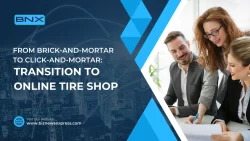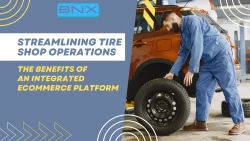Overcoming Common Challenges in the Tire Industry with eCommerce Solutions

There are always difficulties in the tire business. Tire store owners frequently find themselves negotiating a complex landscape, from issues with inventory management to intense rivalry and the never-ending battle to recruit and retain consumers. But in today’s digital world, eCommerce solutions for tire shops are a viable way to overcome these obstacles and take these companies to new heights of achievement. In this blog, we’ll look at the typical tire industry challenges faced by tire shop owners, investigate how eCommerce platforms can be a potent remedy, look at actual success stories, and offer a comprehensive how-to manual for setting up an eCommerce system.
Common Challenges Faced by Tire Shop Owners
Inventory Management
Inventory management is one of the biggest obstacles facing tire store entrepreneurs. It can be challenging to maintain ideal supply levels while reducing overstock or stockouts given the variety of tire brands, sizes, and types available.
Customer Acquisition
Customer acquisition for tire businesses is crucial for business expansion in a market that is becoming more and more competitive. However, it can be difficult to properly connect and engage with potential clients when using traditional marketing approaches, as they may not always produce the desired outcomes.
Competition
There are many companies fighting for market share in the tire industry, which is very competitive. It can be difficult for small independent businesses to stand out and draw clients when they are up against larger chains and internet merchants.
If You are looking for Ready to Use eCommerce Solutions for Tire Industry, please fill the form below for Demo:
How can eCommerce Platforms Address Tire Industry Challenges?
Inventory Management
eCommerce platforms provide tire shop owners with strong inventory management features that let them keep an eye on sales patterns, maintain stock levels, and automate procedures. Shop owners may make the best decisions on stocking their shelves and guarantee they have the proper products available to satisfy client demand by using real-time insights into inventory availability.
Customer Acquisition
Customer acquisition for tire businesses allows owners to reach a wider audience and draw in new clients. Shop owners may efficiently contact potential customers and boost traffic to their online storefront by implementing targeted online marketing strategies, search engine optimization (SEO), and social media involvement.
Competition
Tire stores can set themselves apart from rivals and secure a special place in the market by embracing eCommerce. Shops can differentiate themselves in a crowded market by providing flawless online buying experience, individualized customer care, and value-added services like installation and maintenance.
Step-by-Step Guide to Implementing an eCommerce Solution
Assess Your Needs
It’s critical to evaluate your present business needs and tire industry challenges before implementing eCommerce. Determine the precise problems you’re having with client acquisition, inventory management, and competition. To properly handle these issues, decide what essential features and functionalities you need in an eCommerce system. For instance, you’ll need a platform with strong inventory tracking and replenishment capabilities if inventory management is a top priority.
Choose the Right Platform
After determining your demands, investigate and assess eCommerce platforms that support your company’s objectives. Consider elements like ease of use, scalability, customization possibilities, and compatibility with current systems. Seek platforms with capabilities specific to the tire business, like tools for fitting tires, interaction with the inventory feeds of tire wholesalers, and compliance with industry-standard databases.
Tailor Your Solution
Once a platform has been chosen, carefully collaborate with a reliable eCommerce development partner to tailor the solution to your unique needs. Creating a user-friendly interface that effectively displays your tire products, integrating with current systems like your inventory management software and point-of-sale (POS) system, and adding features like online ordering, appointment scheduling, and virtual tire fitment tools are some examples of this custom eCommerce solution. Make sure the platform conveys your business identity and offers clients an easy-to-use interface.
Train Your Team
Before implementing eCommerce in tire business, make sure to configure and prepare for implementation, and teach your employees thoroughly how to operate the system. Teach them how to perform important duties like order processing, inventory management, product information updating, and online customer service. Ensure that they comprehend the platform’s features, functionalities, and integration with current business processes. Give them continual assistance and resources to ensure a smooth transition to the new system.
Launch and Promote
To raise awareness and increase traffic to your online store, launch your eCommerce platform together with a well-thought-out marketing campaign when it’s ready to go live. Use various platforms to promote the launch, such as email marketing, social media, and search engine optimization. Emphasize the advantages of shopping online at your tire store, including ease of use, a large assortment of products, and exclusive deals or discounts. Customers should be encouraged to browse your online store and to take advantage of any incentives or introductory deals.
Monitor and Adapt
Following the launch, pay special attention to how well your eCommerce platform is performing and get input from both staff and customers. Monitor important data including website traffic, average order value, conversion rates, and customer satisfaction ratings. Make any necessary modifications to your eCommerce strategy using this data to pinpoint areas that want improvement. Maintaining the long-term success of your eCommerce endeavor requires you to be flexible and sensitive to shifts in the market, shifting consumer tastes, and technological improvements.
Real-life Case Studies of eCommerce Tire Brands
Michelin
Michelin Man, its eCommerce site, marked the company’s shift to digital sales channels. With features like virtual fitting, home delivery choices, and tire-choosing tools, this platform provides a flawless online tire shopping experience. Through eCommerce, Michelin increased customer convenience and engagement while broadening its market reach. The change produced a notable spike in online sales, demonstrating Michelin’s capacity to adjust to shifting consumer preferences and make the most of digital technologies to strengthen its position in the market.
Bridgestone
To expedite the tire buying process, Bridgestone introduced “Bridgestone Tire Connect,” an integrated eCommerce website and mobile app. Features offered by the site included simulated tire fitting, comprehensive product details, user reviews, and easy online buying with options for local dealer pick-up or home delivery. Bridgestone has demonstrated its dedication to innovation and client-centric solutions in the digital age by increasing revenues, reaching a wider audience, and improving customer satisfaction through this digital shift.
To Sum Up
eCommerce solutions for tire shop owners gives a strong weapon to get over typical obstacles and prosper in the cutthroat industry of today. Implementing eCommerce in tire business can increase customer base size, streamline operations, and set themselves apart from rivals by utilizing eCommerce systems. In the tire sector, moving to eCommerce can open new potential for growth and success with proper planning and effective implementation.






